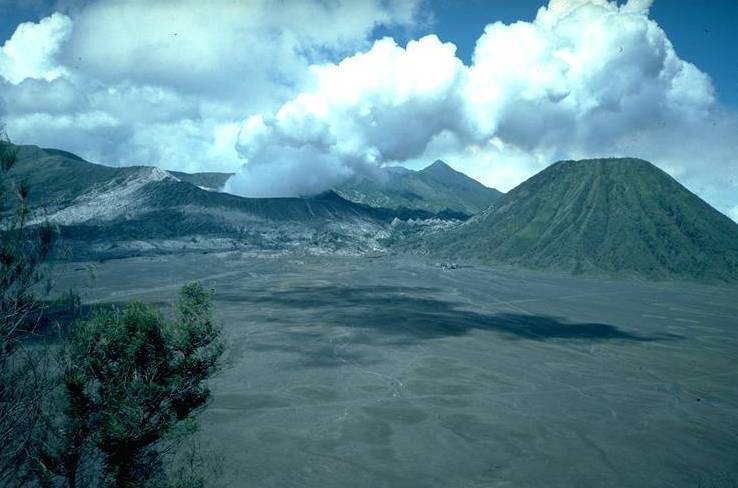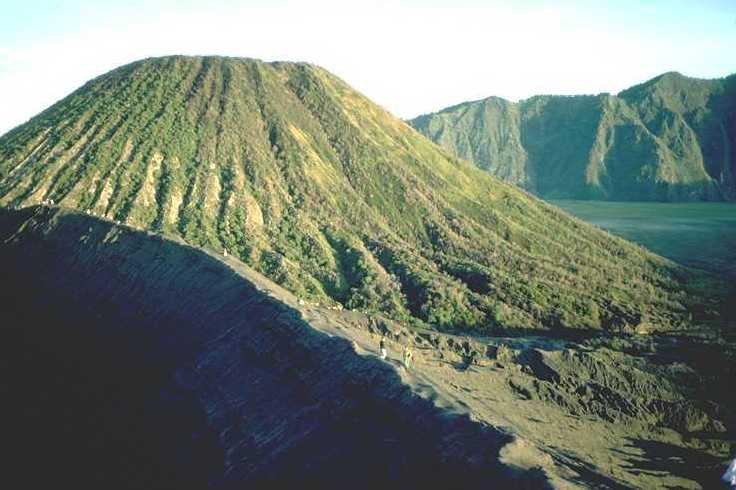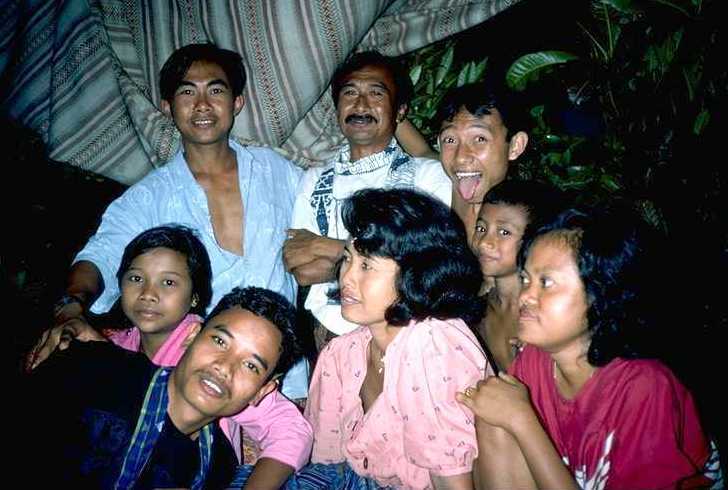




|

|

|

|

In march / april 1995, I travelled around for 4 weeks in Indonesia as a backpacker. The trip was incredibly exciting in all ways; but in addition to my taste for adventures, I am a incarnate trekker, so no matter where I am, I am always looking for mountains. Friends and travel descriptions told me, that a trip to the active vulcano Mount Bromo on Java Island would be an amazing experience. This turned out not to be wrong - or in other words, it became one of my best nature adventures so far!
I had bought a return ticket to Bali + a couple of days at a hotel on the island. The rest of the 4 weeks were all up to my own initiative; and like on all the other occations, this trip confirmed my allegation that your own travel projects always become the most exciting. If possible at all, arranged tours should be avoided, especially in these parts of the world, where the potential for indidual travels is inexhaustible. Apart from the very special (and expensive) trips to remote areas, arranged tours normally blunt your senses, because you get wrapped into a comfort and passivity making your experience seem like a movie through the toned windows of the tourist bus. And by the way, Indonesia is one of whe world's cheapest countries for individual backpackers - unless you demand a standard at the level of Europe's better hotels.
The following is an edited diary from the 3 days of my trip to the Bromo vulcano on Java. The climb is not a difficult one, because it's possible do drive most of the way to the top by car. However, the large, moon-like area at the 2.000 meter level offers an incredible natural scenery.
Java is an enormous island and one of the densest populated areas in the world. In order to reach Java from Bali by land, we have to go to the ferry boat at Gilimanuk on western Bali, where we arrive by bus around 2 o' clock in the afternoon. From here, ferries depart for Ketapang on Java all the time. The boat trip takes about 15 minutes, and on the way, you have a view to the Pacific Ocean and the Indian Ocean at the same time. If you look at a globe you will se, that if you were heading due south west from here by boat, the first visible land would be Antarctica. That's quite a way - about one fourth around the world - but quite interesting to know here in the steaming tropical heat!
On Java, we enter another bus and continue westwards. It seems hard to realize that we are on the island of Java now! In the future, I will think of anything but Java coffee, when I hear the name! The bus now takes us through extensive hardwoods, which make me think of the danish forests in summer. Later, we drive through densely populated areas with rice fields, sugar cane, bananas and many other crops. Here, reality corresponds much more to my expectations: Peasants working in the fields with cone-like hats, tumbrels pulled by oxen, rickshaws and people everywhere.
On my map of Java, I find the town of Situbondo, which the bus is entering now. On the map, it is marked as a tiny dot among several, but it seems to have the size of a major provincial town in Denmark. On my way back from Mount Bromo I spent a day and night here, because I wanted to see a typical indonesian town, and I got a fantastic experience. I didn't meet any tourists, but I met an exceptionally friendly and hospitable population. The explanation of the missing tourists is due to the fact that Situbondo has no golden beaches or historical monuments and therefore isn't mentioned in any tourist guides.
Later, the bus drives on along the Java Sea on northern Java. It's getting dark, and in the dusk, we can see hundreds of small lights on the water. That's the fishermen in their canoes at work. After several hours of driving, we pass another tiny dot on my map, which turns out to be another major town called Probolinggo. Java definitely is a big island! From Probolinggo, we drive away from the coast and start climbing uphill - not very surprising since the top of Mount Bromo is 2.383 meters above sea level.
When we reach the overnight place after numerous hairpin bends, the temperature has dropped remarkably. We are now going to stay overnight at a modest guest house serving as "base camp" for the climb to-morrow. The time is 10 p.m. and we plan to get up at 3 o' clock next morning.
Friday
My alarm clock rings an hour too early because the local time on Java is one hour earlier than Bali. That's one of the consequenses of staying in a big, long country! At 3.30 a.m. we drive the last 6 km along the small road to the ridge of the outer vulcanic crater. The sky is full of stars, and the waning moon is seen like a boat in the sky. From the end of the road, we switch on our torches and start the trekking - first upwards, later about 100 meters downwards. Bromo consists of a minor crater inside a much larger crater, and right now, we are descending along the outer crater ridge. A few kilometers away, we can see a white column of smoke arising against the sky. Bromo is still a very active vulcano - in fact one of the most active vulcanoes in Indonesia. A couple of weeks ago it was so active, that the authorities decided to close the area for tourists. That makes me think of, that it was on the small island of Krakatau close to Java that one of the biggest vulcanic eruptions in historical time took place. In 1883, the island exploded with a boom, which could be heard as far away as Alice Springs in Central Australia, about 3.500 kilometers away, and for months after that event, the sunsets all over the world had a special red colour because of the ashes in the atmosphere!
Later, we walk aross the big, flat lava plain between the outer and inner crater. The white smoke from the vulcano comes closer, and finally, the trail ascends along the inner crater. The dawn is now coming in from the east. In the dusk, we reach the crater ridge, and here, we are encountered by a fantastic view: About 50 meters down, the fire from the interior of the Earth is lightening in the dusk, and the sound from down there reminds me of the rumble of an old fashioned stove! As the daylight increases, we can see the outlines of the mountains against a sky with changing colours, and about an hour after the first dawn, the sun comes up - at a very high speed because we are so close to the equator.
The view from up here is hard to describe. But some months ago, I saw an animated film in the planetary of Copenhagen showing a fantasy flight over the surface of the planet of Mars. That's the closest I can get to a description right now!

After having climbed the summit, I walk all the way along the central crater ridge of Bromo - a one hour trip because it's quite a bit up and down. During this circular trip, I run out of film in my camera because of the great scenery. If you like remote, desert natural landscapes, you can spend days up here without getting bored. The uninhabited, moon-like landscape around Bromo at an altitude of about 2.000 meters above sea level is covering an area of about 10 kilometers with rugged cones emerging in the lava desert. Especially at sunrise when the shadows are long, the scenery is fantastic.
After my return to the road, I decide to stay up here all the day and find a cheap home stay close to the outer crater ridge. For a few dollars, you can get a room with bath including breakfast. That's a very normal price in Indonesia if you keep away from the big and well known tourist sites - and instead of bars and swimming pools, you find grazing cows and inspiring backpackers right outside your door. Right next to the vulcanic scenery there is a fertile and pictoresque area with small villages. Believe it or not, but up here, 2.000 meters above sea level in the javanese highlands, the peasants grow cabbage, carrots, potatoes and a lot of other known and unknown crops. The strange thing is, that several of these vegetables and crops are very well known and grown in Danmark up in the cold Scandinavia of northern Europe. The border between the cultivated land and the crater and lava desert is incredibly sharp. The local villagers are friendly everywhere, and you are free to walk along the trails between
their fields. And their friendliness has no hidden motives. No begging or selling of stupid souvenirs.
Saturday
I slept 2 nights at the nice home stay at Bromo, and this morning, I went by a bemo down to the lowlands. A bemo in Indonesia is a minibus with 8-10 seats functioning like a kind of shared taxi. They have no fixed time scedule, but usually, they are always available when you need them! Normally they are crowded and not very comfortable, but very cheap.
Right now, I am sitting on Saturday night at a hotel in the town of Situbondo in the lowlands of eastern Java, drinking a glass of indonesian whisky, trying to consume all the impressions from my trip. This night, I have been shown around in town, and I was invited to an english teacher's home after visiting his family and a couple of his pupils. Later, we went to the central square of Situbondo with a beer and looked at the people. There were plenty of people everywhere. The religion here on Java (like in most of Indonesia apart from Bali and a few other islands) is islamic. But it's a mild form of Islam. Unlike most of the arab countries in the Middle East, the women are not covering their face on public places. Here they can do with a scarf around their hair. And at 9 p.m. in the town center, the numbers of males and females are quite equal. On the pavement of the city square, two men were sitting playing chess with a big audience. During the whole day, I haven't seen any tourists, because there are no beaches or famous official highlights. I think that's one of the reasons why Situbondo is a nice and friendly place.

On Eastern Bali, close to the village of Tirtagangga, I stayed in the home of this hospitable family.
This has been a fantastic day. During my numerous travels, I don't think the people have been more friendly than in Indonesia. To-morrow, I will return to Bali, and I have planned to spend the last week of my trip on the neighbouring island of Lombok. On Lombok, I am very hooked on Indonesia's third highest mountain Mount Rinjani with an altitude of 3.726 meters! It should be hard to climb at this time of the year because of the rainy season, but the mountain is a holy place for thousands of pilgrims because of some hot springs close to the summit. And in my "Lonely Planet" - guide, there is plenty of more interesting information about it: Under the summit, there is a big, crescent-shaped lake with another vulcanic cone in the middle. That really sounds interesting!

|

|

|

|